
The Noctuidae, commonly known as owlet moths, cutworms or armyworms, are a family of moths. They are considered the most controversial family in the superfamily Noctuoidea because many of the clades are constantly changing, along with the other families of the Noctuoidea. It was considered the largest family in Lepidoptera for a long time, but after regrouping Lymantriinae, Catocalinae and Calpinae within the family Erebidae, the latter holds this title now. Currently, Noctuidae is the second largest family in Noctuoidea, with about 1,089 genera and 11,772 species. This classification is still contingent, as more changes continue to appear between Noctuidae and Erebidae.

Callistege is a genus of moths in the family Erebidae.
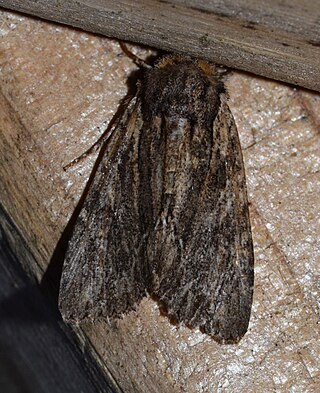
Morrisonia is a moth genus in the family Noctuidae.

Phlogophora is a genus of moths of the family Noctuidae first described by Georg Treitschke in 1825.
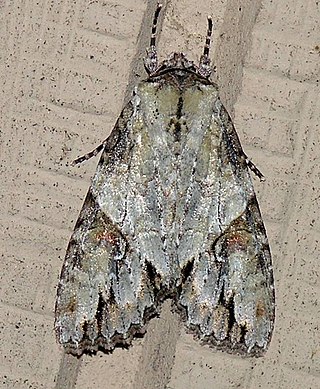
Morrisonia latex, the fluid arches, is a moth of the family Noctuidae. The species was first described by Achille Guenée in 1852. It is found in North America from Nova Scotia to South Carolina, west to Arkansas, and north to Manitoba.

Morrisonia confusa is a moth of the family Noctuidae. It is found in Eastern North America down to Florida, in the north it can be found up to Nova Scotia, New Brunswick, Quebec and Ontario.
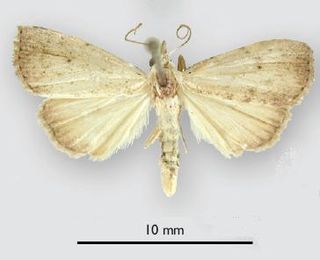
Rivula stepheni is a species of moth of the family Erebidae first described by James Bolling Sullivan in 2009. It is found in the US in eastern North Carolina, Louisiana and Florida.
Abagrotis orbis, the well-marked cutworm or Barnes' climbing cutworm, is a moth of the family Noctuidae. The species was first described by Augustus Radcliffe Grote in 1876. It is in southwestern North America, extending eastward across the plains and with a large disjunct population in dune habitats in the southern Great Lakes area. It extends into western Canada only in the southern interior of British Columbia and southern Alberta and Saskatchewan.
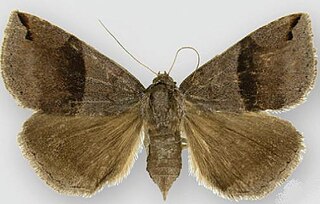
Gondysia similis, the gordonia darkwing is a moth of the family Noctuidae. The species was first described by Achille Guenée in 1852. It is found in the US from North Carolina to Mississippi and Florida. The food plant occurs in Alabama and Mississippi and the moth could be expected from these areas as well.

Gondysia smithii, or Smith's darkwing, is a moth of the family Noctuidae. The species was first described by Achille Guenée in 1852. It is found in the United States, from North Carolina southward to Georgia and westward to Texas northward in the Mississippi Valley to Missouri. It has recently been recorded from Virginia and Florida but not yet from Louisiana or Arkansas, although it does occur close by and would be expected in those states as well. It occurs in open savanna and mesic woodland habitats.

Gondysia consobrina, the consobrina darkwing moth, is a moth of the family Noctuidae. The species was first described by Achille Guenée in 1852. It is found in the US, from North Carolina to Louisiana. Specimens have been recorded from all of the south-eastern states in the range except Alabama and Tennessee.

Schinia lucens, the leadplant flower moth or false indigo flower moth, is a moth of the family Noctuidae. The species was first described by Herbert Knowles Morrison in 1875. It is found in the central and western United States.
Morrisonia mucens, the gray woodgrain, is a moth of the family Noctuidae. The species was first described by Jacob Hübner in 1831. It is found in the United States from coastal Massachusetts south to Florida and west to Texas.

The bicolored woodgrain is a species of moth of the family Noctuidae. It is found from Nova Scotia to Virginia, west to Texas and Manitoba.
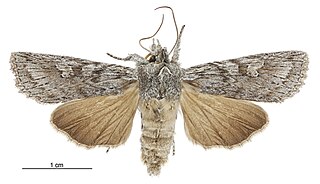
Physetica phricias is a moth of the family Noctuidae. It is endemic to New Zealand. It is wide spread in the South Island and inhabits shrubland. The host of the larvae of this species is matagouri. The adult moths are on the wing from September to May and July, and are attracted both to light and sugar traps.They are a faster-flying species and remain active even during windy conditions. P. phricias can be confused with some forms of P. sequens. However P. phricias can be distinguished as it has a less marbled appearance to its forewing.

Meterana pascoei is a moth in the family Noctuidae, endemic to New Zealand. The name and description were published as Morrisonia pascoei by William George Howes in 1912. It is about 38 mm long, with reddish-brown forewings marked with faint lines and a pair of kidney-shaped marks, and a reddish-brown abdomen with a pronounced tuft at the end. Howes named the species in honour of Merlin O. Pasco of Queenstown, who had sent him 20 specimens caught at a treacle-baited moth trap – Howes had previously collected just two specimens, in 1910. In 1928, in his book The Butterflies and moths of New Zealand, George Vernon Hudson discussed this species, placing it within the genus Melanchra and editing the epithet to "pascoi". John S. Dugdale also used the epithet "pascoi" and proposed several new synonyms for this species in his 1988 publication Lepidoptera - annotated catalogue, and keys to family group taxa.

Callistege triangula is a moth of the family Erebidae first described by William Barnes and James Halliday McDunnough in 1918. It is found in North America, where it has been recorded from Arizona, New Mexico and Texas.
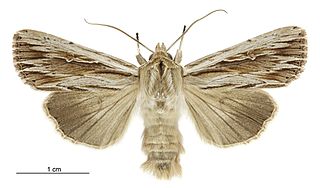
Persectania aversa, commonly known as the southern armyworm, is a moth of the family Noctuidae. It was first described in 1856 by Francis Walker. It is endemic to New Zealand and can be found throughout the country including the North, South, Stewart and Chatham Islands. This species inhabits open grasslands. Larvae feed on grass species including commercial crops such as oats and barley and as a result this species is regarded as an agricultural pest. Adults are nocturnal and are attracted to light. They are on the wing throughout the year.

Physetica temperata is a species of moth of the family Noctuidae. It is endemic to New Zealand and found in the North Island and the top of the South Island in coastal areas. P. temperata is unlikely to be confused with other species in its range, even though it is not distinctively patterned. It is possible that males might be confused with males of P. homoscia but this latter species is much larger. P. temperata can be distinguished from P. caerulea as the former species has forewing veins that are marked black and a chequered forewing fringe. The adults of this species are on the wing from September to March. The life history of this species has not been well documented although it is thought that larval host species is Ozothamnus leptophyllus.
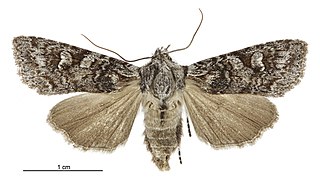
Physetica longstaffi is a species of moth of the family Noctuidae. It is endemic to New Zealand and found in the North and South Islands. This species lives in open habitats and shrublands, at altitudes ranging from the low alpine zone down to sea-level. As at 2017 the biology of this species is in need of further investigation as there is no published description of the larvae of this species nor have larval specimens been preserved in collections. There is also confusion over the possible larval host plants for this species. This species is on the wing from February to May. There is also a record from the North Cape in December. The adults of this species is attracted to light. P. longstaffi might possibly be confused with P. sequens or P. phricias. However unlike both P. sequens and P. phricias, P. longstaffi has a large oval mark near the centre of the forewing. Other distinguishing features include further differences in the colouration of the forewings of P. longstaffi as well as differences in the third labial palp segment of the male and differences in the shape of the male genitalia.
















